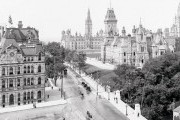Otta-Blog
Archives
April, 2017June, 2015
May, 2015
March, 2015
November, 2014
June, 2014
May, 2014
April, 2014
March, 2014
July, 2013
We stayed there over Canada Day yet again. I can't say enough good things. The room was fantastic, the Inn is very close to Parliament Hill and the Market, and the food was great. - Doug Cambell, Montreal
History of Ottawa
March 17, 2014 - Ottawa History & Culture
McGee's Inn (B&B) has been in business in Ottawa for 30 years. We are proud to be part of the history of Ottawa. McGee's Inn was built in 1886.
The History of Ottawa, capital of Canada, was shaped by events such as the construction of the Rideau Canal, the lumber industry, the choice of Ottawa as the location of Canada's capital, as well as American and European influences and interactions. By 1914, Ottawa's population had surpassed 100,000 and today it is the capital of a G7 country whose metropolitan population exceeds one million.
For centuries, Algonquin people have portaged through the waterways of both the Ottawa River and the Rideau River while passing through the area. French explorer Étienne Brûlé was credited as the first European to see the Chaudière Falls in 1610, and he too had to portage past them to get further inland. No settlement occurred until the early 1800s after early Gatineau was founded near the falls, but across the Ottawa River from Ottawa.
The construction of the Rideau Canal, spurred by concerns for defense following the War of 1812 and plans made by Colonel By and Governor General Dalhousie began shortly after September 26, 1826 when Ottawa's predecessor, Bytown was founded. Colonel By was an officer of the Royal Engineers commissioned by the Imperial Government in 1827 to superintend the construction of the Rideau Canal. [1]
The founding was marked by a sod turning, and a letter from Dalhousie which authorized Colonel By to divide up the town into lots.[2] The town developed into a site for the timber, and later sawed lumber trade, causing growth so that in 1854, Bytown was created a city and its present more appropriate name, Ottawa was conferred.[3]
Shortly afterward, Queen Victoria chose Ottawa as the capital of Canada; and the parliament buildings on Parliament Hill were soon completed. Also at this time, increased export sales led it to connect by rail to facilitate shipment to markets especially in the United States. In the early 1900s the lumber industry waned as both supply and demand lessened.
Growth continued in the 20th century, and by the 1960s, the Greber Plan transformed the capital's appearance and removed much of the old industrial infrastructure. By the 1980s, Ottawa had become known as Silicon Valley North after large high tech companies formed, bringing economic prosperity and assisting in causing large increases in population in the last several decades of the century. In 2001, the city amalgamated all areas in the former region, and today plans continue in areas such as growth and transportation.
Indigenous peoples and European exploration
The Ottawa Valley was the traditional home of the Algonquin people (Anishinaabe) who called the Ottawa River the Kichi Sibi or Kichissippi' meaning "Great River" or "Grand River". The word "Ottawa" is in relation to the Ottawa people, the First Nation who hunted, camped, traded, and traveled in the area, and also lived far to the west along Georgian Bay and Lake Huron. The Ottawa Algonquians maintained a trade route along the Ottawa River for a relatively short time.
When Étienne Brûlé in 1610 became the first European to travel up the Ottawa River, followed by Samuel de Champlain in 1613, they were assisted by Algonquin guides. Written records show that by 1613 the Algonquins were in control of the Ottawa Valley and the suChamplain wrote about both the Rideau Falls (named by later canoists) on the eastern part of the early future town, and the Chaudière Falls (named by Champlain) in the west, which would later become employed in the lumber industry. Unlike some parts of Gatineau, and areas much further upstream, there are no indications of any settlement at all in present day Ottawa for the next two centuries, however the river and the Rideau River had been used for travel. Chaudière was, and still is impassable by any water traffic, so there were portage paths around it on trips from the mouth of the Ottawa River to the lands of the interior and Great Lakes. Many missionaries, coureurs de bois and voyageurs passed by Ottawa, such as Jesuit martyr Jean de Brébeuf in 1634, on his way to the Hurons, Groseilliers in 1654,Radisson, and in the 1700s explorers La Vérendrye (who made four trips west in the 1730s and 1740s), and later Alexander Mackenzie, Joseph Frobisher and Simon McTavish. Nicholas Gatineau also traded using the nearby Gatineau River.
The Algonquin were not the only people in present day Ontario. During the 17th century, the Algonquians and Hurons fought a bitter war against the Iroquois. Champlain's travels brought him to Lake Nipissing and Georgian Bay to the center of Huron country near Lake Simcoe. During these voyages, Champlain aided the Hurons in their battles against the Iroquois Confederacy. As a result, the Iroquois would become enemies of the French and be involved in multiple conflicts (known as the French and Iroquois Wars) until the signing of the Great Peace of Montreal in 1701.
